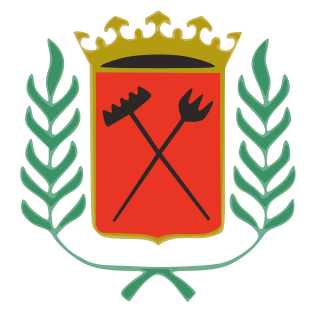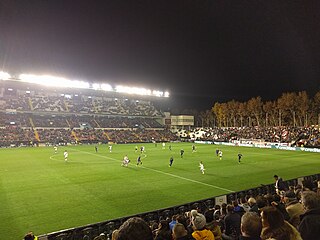
La Palma, also known as La isla bonita and historically San Miguel de La Palma, is the most northwesterly island of the Canary Islands, Spain, which is a Spanish autonomous community and archipelago in Macaronesia in the North Atlantic Ocean. La Palma has an area of 708.32 square kilometres (273.48 sq mi) making it the fifth largest of the eight main Canary Islands. The total population at the start of 2023 was 84,338, of whom 15,522 lived in the capital, Santa Cruz de La Palma and 20,375 in Los Llanos de Aridane. Its highest mountain is the Roque de los Muchachos, at 2,426 metres (7,959 ft), being second among the peaks of the Canaries after the Teide massif on Tenerife.
La Antigua is a municipality in the Mexican state of Veracruz. The city of José Cardel serves as the municipal seat. La Antigua is regarded as the first real Spanish town in Mexico.

Vallecas was a municipality of Spain that disappeared as such in 1950, when its annexation to the municipality of Madrid took place. Nowadays, the territory is roughly occupied by two districts: Puente de Vallecas and Villa de Vallecas.

Laredo is a town in the autonomous community of Cantabria, Spain. According to the 2008 census (INE), the municipality has a population of 12,648 inhabitants. In addition to Laredo, the municipality includes the villages of La Arenosa, El Callejo, Las Cárcobas, Las Casillas, La Pesquera, Tarrueza and Villante. Except from the last two, the other villages had been physically integrated into Laredo.

Puente Genil is a Spanish city in the province of Córdoba, autonomous community of Andalusia. It is situated about 45 miles (70 km) from the provincial capital, Córdoba. It has a population of around 30,000 people.

Almodóvar del Campo is a municipality of Spain, located in the province of Ciudad Real, autonomous community of Castilla–La Mancha. Featuring a total area of 1.208,25 km2, it is the largest municipality in the region and one of the largest municipalities in Spain. As of 1 January 2020, it had a population of 5,983.

San Sebastián de los Reyes is a municipality in the Community of Madrid, Spain. Founded in 1492, it is located 20 kilometres (12 mi) north of Madrid.

The Bridge of Stone is a bridge in Lima, Peru. It was built in 1608 by the architect Juan del Corral to link Lima with Rímac. It is the beginning of the jirón de la Unión, which was, in the first independent years of Peru, the most important road in the city. Until 1861, it was the only bridge in the city.

Entrevías is a neighbourhood of Madrid belonging to the district of Puente de Vallecas. As of 2019 it was the poorest neighborhood in the municipality.

El Puente del Arzobispo is a municipality of Spain located in the province of Toledo, Castilla–La Mancha. The municipality spans across a total area of 0.98 km2 and, as of 1 January 2020, it has a registered population of 1,225. Together with neighbouring Talavera de la Reina, El Puente del Arzobispo was a producing centre of Maiolica pottery in Early-Modern Spain.

Rillo de Gallo is a municipality located in the province of Guadalajara, Castile-La Mancha, Spain. According to the 2004 census (INE), the municipality has a population of 74 inhabitants.

Almazán is a municipality located in the province of Soria, Castile and León, Spain. As of 2013, the municipality has a population of 5,843 inhabitants. It is also the seat of the judicial district of Almazán, and ecclesiastically it belongs to the Diocese of Osma, a suffragan diocese of the Archdiocese of Burgos. Connected via the Autovía A-15 and Carretera nacional N-111, it is situated 194 kilometres (121 mi) by road northeast of Madrid. The town lies on the east bank of the Duero river.

The Herrerian style of architecture was developed in Spain during the last third of the 16th century under the reign of Philip II (1556–1598), and continued in force in the 17th century, but transformed by the Baroque style of the time. It corresponds to the third and final stage of Spanish Renaissance architecture, whose dominant trend had been towards austerity and minimal decoration. The ornate Plateresque style had given way to classical Purism in the second third of the 16th century. Purism in turn had given way to the geometric simplicity of the Herrerian style.
Ejutla de Crespo is a city and a municipality of the same name, in the central valleys of the Mexican state of Oaxaca. It is part of the Ejutla District in the south of the Valles Centrales Region.

Campo de Fútbol de Vallecas is a football stadium in the Madrid district of Puente de Vallecas, Spain. It currently hosts football matches and is the home of Primera Division club Rayo Vallecano. The stadium holds 14,708 spectators and was opened on 10 May 1976. It was constructed between 1972 and 1976, and it is also known by the names of Campo de Fútbol de Vallecas and Estadio Puente de Vallecas.
Federal Highway 95 connects Mexico City to Acapulco, Guerrero. The Autopista del Sol is a tolled alternative, which bypasses several towns of the state of Guerrero, including the city Iguala, and thus reduces transit time between Acapulco from Mexico city from 8 hours to almost 3.5 hours.

Madarcos is a municipality of the Community of Madrid, Spain. It has an area of 8.46 km2 with a population of 49 inhabitants and a density of 5.79 inhabitants / km2 it is the town with the lowest population in the Community of Madrid.

Olmedo is a municipality in the province of Valladolid, Spain. The Mudéjar theme park is located here.

Teresa Mañé i Miravet (1865–1939), also known by her pen name Soledad Gustavo, was a Catalan teacher, editor and writer. As a proponent of progressive education, Mañé founded some of the first secular schools in Catalonia. With her husband Joan Montseny, she edited the magazine La Revista Blanca, in which she elaborated her ideas on anarchism, feminism and pedagogy. Her daughter Frederica Montseny i Mañé went on to become a leading figure in the Spanish anarchist movement and the Minister of Health of the Second Spanish Republic.


















